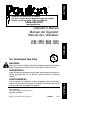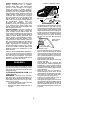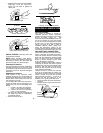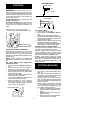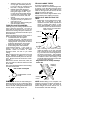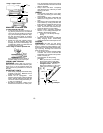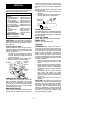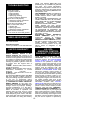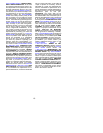
3
open flames, or work that could cause
sparks. Allow engine to cool before re-
fueling.
S
Mix and pourfuel in anoutdoor areaon
bare ground; store fuel in a cool, d ry,
well ventilated place; and use an ap-
proved, marked container for all fuel
purposes. Wipe upall fuelspills before
starting saw.
S
Move at least 10 feet (3 meters) from
fueling site before starting engine.
S
Turnthe engine off andlet sawcool ina
non-combustible area, not on dry
leaves, straw, paper, etc. Slowly re-
move fuel cap and refuel unit.
S
Store the unit and fuel in an area where
fuel vapors cannot reach sparks or
open flames from water heaters, elec-
tric motors or switches, furnaces, etc.
KICKBACK
WARNING:
Kickback can occur when
the moving chain contacts an object at the
upper portion of the tip of the guide bar or
when the wood closes in and pinches the
saw chain in the cut. Contact at the upper
portion of the tip of the guide barcancause
the chain to digi nto the object, which stops
the chain for aninstant. The result is alight-
ning fast, reverse reaction which kicks the
guide bar upand backtoward the operator.
If the saw chain is pinched along the top of
the guide bar, the guide bar can be driven
rapidly back t oward the operator. Either of
these reactions can cause loss of saw con-
trol whichcanresult inserious injury.
Guard
against kickback
Rotational Kic kback
is the rapid upward
and backward motion of the chain saw that
can occur when the moving saw chain near
the upper portion of the tip ofthe guide bar
contacts an object such as a log or a
branch.
Pinch-Kickback and Pull-In occur when the
chain is suddenly stopped by being
pinched, caught, or bycontacting aforeign
object in the wood. This sudden stopping
of the chain results in areversal ofthe chain
force used to cut wood andcauses the saw
to move in the opposite direction of the
chain rotation. Pinch-Kickback drives the
saw straight back toward the operator. Pull-
In pulls the saw awayfrom the operator. Ei-
therreaction canresult inloss ofcontrol and
serious injury.
Avoid Pinch---Kickback:
S
Be extremely aware of situations or ob-
structions that can cause material to
pinch the top of or otherwise stop the
chain.
S
Do not cut more thanone log at atime.
S
Do not twist the saw as the bar is with-
drawnfrom anundercut whenbucking.
Avoid Pull --- In:
S
Always begincutting withthe engine at
full speed andthe saw housing against
wood.
S
Use wedges made of plastic or wood.
Neverusemetaltoholdthecutopen.
Kickback Path
Avoid Obstructions
Clear The Working Area
REDUCETHECHANCEOF
KICKBACK
S
Recognize that kickback can happen.
With a basic understanding of kick-
back, you can reduce the element of
surprise which contributes to acci-
dents.
S
Never let the moving chain contact any
object at the tip of the guide bar.
S
Keep the working area free from ob-
structions such as other trees,
branches, rocks, fences, stumps, etc.
Eliminate or avoid any obstruction that
your saw chain could hit while you are
cutting through a particular log or
branch.
S
Keep yoursaw chainsharp andproper-
ly tensioned. A loose or dull chain can
increase the chance of kickback occur-
ring. Follow manufacturer’s chain
sharpening and maintenance instruc-
tions. Check tension atregularintervals
with the engine stopped, never with the
engine running. Make sure the bar
clamp nutsare securely tightened after
tensioning the chain.
S
Begin and continue cutting at full
speed. Ifthechainismovingataslower
speed, there is greater chance of kick-
back occurring.
S
Cutonelogatatime.
S
Use extreme caution when re-entering
apreviouscut.
S
Do not attempt cuts starting with the tip
of the bar (plunge cuts).
S
Watch for shifting logs or other forces
that could close a cut and pinch or fall
into chain.
S
Use the Reduced---Kickback Guide Bar
and Low---Kickback Chainspecified for
your saw.



